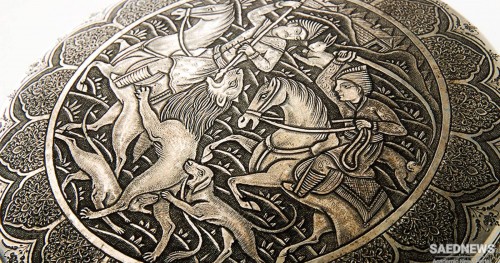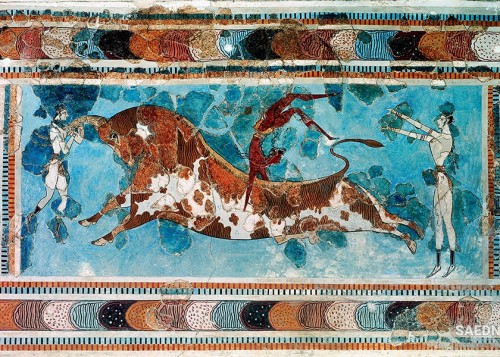During the early Qajar era Iran (Persia, as it was then known to the West) emerged from the political turmoil and economic decline of the late eighteenth century with a relatively stable central government, increased social homogeneity, an expanding economy, and gleams of cultural and religious revival. From the first quarter of the nineteenth century Iran also experienced diverse challenges from outside its borders. Russia and Britain came into extensive contact with Iran in its northern and southern frontiers, not only through war, diplomacy, and trade but later by introducing new social and political ideas and institutions. Unlike India to its southeast and the Caucasus and Central Asia to its north, Iran was never conquered or colonized by its European neighbors, but like the Ottoman Empire to its west, it never remained immune from the European powers' all-embracing, and often intrusive, presence.
It did not abandon its own political system, culture, and way of life, yet it did not shun altogether Europe's material, and later cultural, dominance. Gradual awareness of, yet ambivalence toward, the West's pervasive ways was at the heart of the Qajar experience. It is not by mere coincidence that Europe's "long century"—as the period between the 1789 French Revolution and the 1914 outbreak of World War I is known—finds a certain resonance in the Qajar period. The Persian long century began in earnest in 1785 with the accession to the throne of Aqa Muhammad Khan (1785–1797), the founder of the Qajar dynasty, and came to an effective end with the Constitutional Revolution (1906–1911). The establishment of the Qajar dynasty under Aqa Muhammad Khan unified the country and created an enduring equilibrium after nearly half a century of chronic upheaval. The Constitutional Revolution, by contrast, was an attempt to develop democratic institutions based on the rule of law, conscious nationalism, and secular reforms. The period in between witnessed a long, often painful process of transformation and adjustment to the internal and external realities that defined modern Iran as a state and a nation.
During the first six decades of Qajar rule, three overlapping themes shaped the Persian state and society. In rough chronological order, the first of these was the loosening of tribal loyalties and their gradual replacement with traditional patterns of monarchy and bureaucracy; the second was the encounter with European powers and subsequent adjustment to their strategic and economic contingencies; and the third was the state's interaction with indigenous social and religious forces that sometimes challenged its legitimacy. None of these themes proved detrimental to the survival of the Qajar state, but they combined to produce a serious crisis in the decade leading up to Nasir al-Din's accession.
In the 126 years between the fall of the Safavid state in 1722 and the accession of Nasir al-Din Shah, the Qajars evolved from a shepherd-warrior tribe with strongholds in northern Iran into a Persian dynasty with all the trappings of a Perso-Islamic monarchy. Before Aqa Muhammad Khan could place the Kayanid crown on his head in 1785, three generations of the Qajars had lost their lives in the struggle for the throne. As a prominent contingent within the Qizilbash confederacy (the military elite of the Safavid era), the Qajar chiefs considered themselves legitimate candidates for royal power. During the three interregnums in the eighteenth century, they fought bloody contests with other claimants to the Persian crown, first with Nadir Shah (1736–1747) and his Afsharid successors and then with Karim Khan Zand (1750–1779) and his successors. It was not just out of flattery that court chroniclers of later decades reconstructed the early history of the Qajar dynasty. By elevating three generations of Qajar chiefs to the rank of full-fledged kings, they tried to depict the Qajars as legitimate successors to the Safavids, whose right to the throne was usurped by rival dynasties.
Aqa Muhammad Khan, who was castrated in his youth by an Afsharid pretender to the throne (a common practice for disqualifying accession), spent years in the Zand court in Shiraz as a hostage for his clan's shaky loyalty. But immediately after Karim Khan's death in 1779, Aqa Muhammad took refuge with his tribe in Astarabad and began a resurgence that eventually made him the master of Iran. In a series of campaigns that took nearly two decades of his life and continued up to the time of his own assassination in 1797, he managed first to subdue the north and then to supplant Zand rule in the south and overcome all but the most persistent of his domestic rivals. When in 1786 he chose Tehran as his capital, he had unified under his rule nearly all of the interior of Iran, though most of the peripheral regions of Azarbaijan and the Caucasus, Khurasan, and the Persian Gulf littoral remained outside his reach. Aqa Muhammad Khan's long and sometimes destructive campaigns were in part motivated by desire for conquest and booty and a sense of vengeance against his rivals. Yet he was also an empire builder with a consistent and clear vision. Notwithstanding his infamous greed and cruelty, which brought about the destruction of many of his enemies and some of his supporters, he should be credited for ultimately bringing back security and peace to a country much abused by civil war, famine, and depopulation.
The Qajar bid for power was the third successive attempt to create a political order in place of and on the model of the Safavid empire. Being the last in a struggle for domination that since the second decade of the eighteenth century had exhausted the Afghans, Afshars, Zands, and numerous other tribal forces on the Iranian periphery no doubt was an advantage to the Qajars. Aqa Muhammad Khan won the last phase of the contest because he had been able to build up a potent war machine at the back of his own quarreling Qajar tribal forces and their allies. There were other reasons, too. The Qajars' rapid adoption of a versatile model of government helped them achieve a state-tribe optimum that had been inconceivable even under a peaceful ruler such as Karim Khan Zand. Moreover, with the emergence of the two European powers on the Iranian horizon at the outset of Qajar rule, the regional climate favored greater stability.
Aqa Muhammad Khan learned from the failures of his predecessors some important lessons in government. He appreciated the collective nature of a tribal enterprise that allowed him to pave the long and bloody way between the Qajar tent camp in Astarabad and Gulistan Palace in Tehran. Yet in his own lifetime he had witnessed the internecine feuding that destroyed previous ruling houses. He thus tried his best to eliminate within and without the Qajar house all actual and potential threats to his designated successor. His nephew and heir apparent, Baba Khan, later known as Fath 'Ali Shah (1797–1834), was the prime beneficiary of Aqa Muhammad Khan's actions. It took another half-century before the Qajars could fully eradicate all rivalries within their own house, but the seed of royal supremacy was already sown.
The reign of Fath 'Ali Shah marked a clear shift from the tribal warring tradition to a model of kingship. Under his rule the Qajar state was able to expand its control to the peripheries of Azarbaijan, Khurasan, and southern Fars. It also managed to establish an extensive court and administration with all the trappings of a Persian royal system. Fath 'Ali Shah's personality and his taste for luxury and royal extravagance, in contrast to the warlike austerity of his uncle, proved remarkably suitable for reconstruction of such a royal system The early Qajars viewed "the men of the sword" as prime tools of their domination over the land they conquered. The army created by Aqa Muhammad Khan from a conglomerate of northern tribal forces and maintained by Fath 'Ali Shah proved a resilient instrument in the face of early internal dissension and external challenges. Aqa Muhammad Khan's ambition was to restore the old boundaries of the Safavid empire in the Iranian periphery to include principalities of Afghanistan and Central Asia, the Ottoman Iraq, all of the Kurdish region and frontiers of Anatolia, the Caucasian provinces, and the Iranian coasts and islands of the Persian Gulf. This plan was only partially modified under Fath 'Ali Shah. The same spirit of warfare as the basis of imperial domination remained a part of the Qajar ethos under Muhammad Shah (1834–1848) and during Nasir al-Din's early reign.
The early Qajars were also keenly aware of the value of "the men of the pen," who were responsible for the government administration (divan ). Aqa Muhammad Khan's callous treatment of many real and potential rivals seldom was aimed at state officials. He soon began to appreciate the role of officialdom in creating the state apparatus and overseeing its fiscal and military functions. Fath 'Ali Shah was even more consistent in recruiting into his administration secretaries and city officials from Mazandaran and Iraq 'Ajam and from remnants of the Zand bureaucratic families of Fars. These officials often held strong bonds with the 'ulama, the merchants of the bazaar, and with other notables and served as channels of communication with these groups. In Fath 'Ali Shah's service there was also a contingent of Georgians and other Caucasians of slave origin as well as those who had immigrated from the Caucasus to Azarbaijan after the Persian defeat in war with Russia. Some served as eunuchs and servants of the inner court, and others were in the army. Under Muhammad Shah a number of these Georgians, along with Kurdish and other peripheral elements, were recruited into important government posts.
By the middle of the nineteenth century there was an entrenched class of officials acutely aware of its own interests and privileges. Based largely on regional and clan allegiances, they were divided into four informal factions. With a few exceptions, most members of this class were conservative in their specialized skills. In spite of the enormous power ministers and state accountants wielded throughout the Qajar era, these factions never fully integrated into a unified administrative entity distinct from the court. Their power remained, both in theory and in practice, momentary and contingent on the shah's arbitrary wishes and thus vulnerable to the machinations of the court and the nobility. They were, as they often wished to assert, a class of servants (tabaqa-yi naukar ) in the shah's retinue.
From Nadir's mistakes the early Qajars also learned the need to court the increasingly influential Shi'ite establishment, the 'ulama, the "men of [religious] learning." Even more than Aqa Muhammad Khan, his successor, Fath 'Ali Shah, ensured their loyalty through patronage, by dispensing gifts and land tenures and sanctioning their judicial authority. As has often been noted, the Qajars clearly felt they needed the 'ulama's consent and cooperation in order to buttress their own precarious legitimacy as successors to the Safavids. Whatever the drawbacks of complying with the 'ulama's wishes and whatever the 'ulama's ambivalence in collaborating with the Qajar shahs, both sides benefited from this symbiosis. The shahs successfully presented themselves as patrons of the faith and defenders of the Shi'ite kingdom, whereas the 'ulama consolidated their social base under the aegis of the state. Greater integration of Shi'ism in the Qajar era as the religion of the state and of a vast majority of people reinforced the state-'ulama bonds.
The shah and his court, the princes and the nobility, the army chiefs and the officials, and to an extent the 'ulama constituted the ruling elite of the Qajar state. Yet in practice the effectiveness of the government was hampered by inherent limitations. Throughout the Qajar period the state suffered from inefficiencies and malfunctions caused by financial restraints, factionalism, organizational confusion, and intrinsic corruption. The state's financial weakness was essentially caused by Iran's stagnant agrarian economy and obstacles to the growth of trade and industrialization, which in turn handicapped the government's ability to raise taxes and improve its archaic methods of expenditure. Moreover, the court and the nobility treated state revenues from the land and other sources as legitimate spoils of the conquest that primarily were to be spent for their upkeep. Little revenue therefore was allocated toward meaningful expansion of the state. The officials shared these spoils with the royalty and the Qajar nobility to maintain their economic privileges and ensure monopoly over the bureaucratic machinery.
Impediments to strong government were deepened by obstacles at the provincial level. Local power bases, whether chiefs of tribal confederacies or prince governors of the Qajar house, reserved a certain degree of autonomy in the provinces. The shah maintained a fragile control over these domains, though it is wrong to believe that such control was merely nominal. Depending on the strength of the ruler and his administration he could maneuver, negotiate, or coerce, whichever was expedient, thus holding indirect sway over the provinces. Yet they could not, and indeed did not wish to, reverse the delicate balance between the center and the periphery. Such devolution of power was seen as cost-efficient and pragmatic. Through practices such as assigning provincial governments to the highest bidder, allotting land and hereditary pensions to the nobility, army officers, and court and government officials, and awarding gifts to the 'ulama, the shah exercised his royal power in preserving this precarious balance. Punitive measures such as the dismissal, banishment, and execution of guilty officials and chiefs (or whoever posed or was presumed to pose a threat to the royal hegemony) were among other royal options. So was the increasingly abused practice of bestowing grandiose titles to the nobility and to all servants of the state.[7] In exchange the Qajar elite and the officialdom demonstrated devotion to the shah not only through military and civil service but by paying symbolic and material homage. Such displays of loyalty ranged from substantial gifts (pishkish ) presented to the shah on special occasions to perpetual assurances of humility, devotion, and flattery.
That such a system of reciprocal favoritism was prone to serious abuses was acknowledged even by its practitioners. The shah and his ministers resigned themselves to the fact that no reform measure could remedy the defects of this time-honored system. Increasingly from the second quarter of nineteenth century, and more so after the breakdown of the princely system of Fath 'Ali Shah's time, governorships of provinces were auctioned off to the highest bidders among princes of the blood, Qajar chiefs, and bureaucrats. From a purely utilitarian standpoint, the Qajar shahs viewed this annual farming out of provincial offices as an efficient way to raise revenue without directly involving the central government in the costly and laborious practice of collecting taxes. Revolving governorships had for the shah the additional advantage of weakening the semiautonomous power bases of princes and members of the nobility. Yet this system routinely exposed the public, particularly the villagers, to the indiscretion and avarice of provincial and district governors and their tax collectors. Governors tended to look upon their posts as transitory means of generating income not only to recoup the initial sums they pledged to the central government but also to amass a surplus income (madakhil ) for themselves and their agents. In such a hierarchy of oppression there was little incentive for fairness and compassion. As the central government's ability to raise income dwindled, officials' incentive to maximize their surplus earnings swelled, thus turning the madakhil into an institutionalized form of corruption at every level of government.


 Shia Islam Turns into the Official Religion of Iran by Safavids
Shia Islam Turns into the Official Religion of Iran by Safavids














































